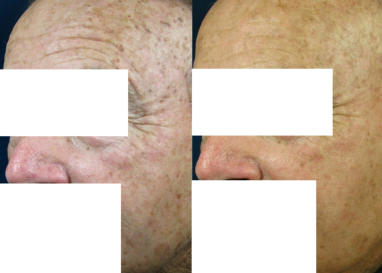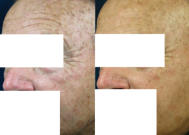PHOTODYNAMIC THERAPY (PDT) FOR SUN DAMAGE & PRE-CANCERS
Copyright © 2025 M Beauty Clinic by Dr. Tess
Dr. Tess Mauricio, MD, FAAD is
a Board Certified Dermatologist
from Stanford University Medical
School. She graduated Summa
Cum Laude from UCSD and is a
past President of the San Diego
Society of Dermatological
Surgery. She is known
worldwide as “America’s
Favorite Dermatologist.”
SERVICES

What is photodynamic therapy?
Photodynamic therapy or PDT is a treatment that uses special drugs, called
photosensitizing agents, along with light to kill cancer cells. The drugs only work after
they have been activated or “turned on” by certain types of light, such as laser
treatments. PDT may also be called photoradiation therapy, phototherapy, or
photochemotherapy.Over a certain amount of time the drug is absorbed by the cancer
cells. Then light is applied to the area to be treated. The light causes the drug to react
with oxygen, which forms a chemical that kills the cells. PDT might also help by
destroying the blood vessels that feed the cancer cells and by alerting the immune
system to attack the cancer.
PDT has shown to have great cosmetic benefit as well. The sun causes damage called
photo-aging and the PDT also reverses many of these issues. Over time, skin ages and
loses its youthful appearance. Wrinkles appear around the eyes, fine lines bloom
around the lips, and age spots surface on the hands. While some of these factors are
natural and unavoidable, many of the visible signs of aging are caused by the sun, and
can be avoided.
What does the PDT treat
•
Pre-cancerous lesions such as actinic keratoses (AK)
•
Sun damage
•
Generalized redness
•
Weathered looking skin
•
Rough textured skin due to sun damage
•
Large pores
•
Certain types of skin cancers
Benefits of PDT for Pre-Cancers
Studies have shown that PDT can work as well as surgery or radiation therapy in
treating certain kinds of cancers and pre-cancers. It has some advantages, such as:
•
It has no long-term side effects when used properly.
•
It’s less invasive than surgery.
•
It usually takes only a short time and is most often done as an outpatient.
•
It can be targeted very precisely.
•
Unlike radiation, PDT can be repeated many times at the same site if needed.
•
There’s no scarring after the site heals.
•
It often costs less than other cancer treatments.
•
Have the treatment done regularly to reduce your risk of skin cancer
Why We Are PDT experts
•
Dr Tess is a board certified Dermatologist
•
She is a skin expert and is extremely knowledgable in treating skin with laser
•
She has been offering PDT for over 10 years
•
We not only treat your medical concerns but we can combine the latest in
cosmetic treatments to get your skin looking years younger
•
While many doctors prefer to freeze off pre-cancerous cells, Dr. Tess knows that
over time this causes unsightly white marks on the skin. She prefers using PDT using
aminolevulinic acid (ALA) because this leaves the skin smoother, brighter and
rejuvenated.
What is treatment like?
Aminolevulinic acid (Levulan) is a solution that’s put directly on the skin and areas of
actinic keratosis (AK). Unlike other pre-cancer treatments, it does not reach other parts
of the body. This means the lesions are specifically targeted and other areas are not.
To increase absorption we apply the Levulan with a Microneedling device. The Levulan
is left on the affected skin for about 1-2 hours. A high quality numbing cream is also
applied to ensure maximum comfort during the laser treatment. Levulan is activated by
laser light. We prefer using the ELOS Fotofacial IPL to target pre-cancerous cells as
well as general sun damage and redness. You may feel stinging or burning once the
area is exposed to the laser light. Your skin will feel warm and sunburned after
treatment.
What to expect after treatment
IT IS IMPORTANT TO STAY OUT OF THE SUN AND AWAY FROM BRIGHT LIGHTS
FOR THE FIRST 2 DAYS AFTER TREATMENT. We recommend that you stay home for
the first 2 days after treatment to avoid unnecessary exposure to light. Do not solely
rely on topical sunscreen during this time because your skin will be extremely sensitive
to the sun. The treated areas may get red and crust for 1 week. Most patients just look
like they had a bad sunburn for a few days. Brown spots and pigmented sun damage is
more pronounced and sloughs off after about 1 week. Generally the more sun damage
you have, the more severe the downtime. We offer healing products that help alleviate
much of the issues dealt with while healing.
How many treatments will I need
The number of treatments needed depends on the following
•
severity of the sun damage
•
how aggressive we are able to treat your skin
•
how responsive you are to treatment
•
how much downtime you are able to have
•
your goals
Most patients notice significant improvement in a single treatment but for maximum
results, 2-3 treatments done every month may be necessary.


Dr. Tess patient Before / After

TOLL FREE 1(833)462-3288
Aesthetics & Regenerative Medicine - Beverly Hills, San Diego, Chula Vista
*w/Cosmetic Consultants
$250 fee w/Dr. Tess, applied towards
any purchase or service

PHOTODYNAMIC THERAPY (PDT) FOR SUN DAMAGE & PRE-CANCERS
SERVICES
POPULAR LINKS
What is photodynamic therapy?
Photodynamic therapy or PDT is a
treatment that uses special drugs,
called photosensitizing agents, along
with light to kill cancer cells. The
drugs only work after they have been
activated or “turned on” by certain
types of light, such as laser
treatments. PDT may also be called
photoradiation therapy, phototherapy,
or photochemotherapy.Over a certain amount of time the drug is
absorbed by the cancer cells. Then light is applied to the area to
be treated. The light causes the drug to react with oxygen, which
forms a chemical that kills the cells. PDT might also help by
destroying the blood vessels that feed the cancer cells and by
alerting the immune system to attack the cancer.
PDT has shown to have great cosmetic benefit as well. The sun
causes damage called photo-aging and the PDT also reverses
many of these issues. Over time, skin ages and loses its youthful
appearance. Wrinkles appear around the eyes, fine lines bloom
around the lips, and age spots surface on the hands. While some
of these factors are natural and unavoidable, many of the visible
signs of aging are caused by the sun, and can be avoided.
What does the PDT treat
•
Pre-cancerous lesions such as actinic keratoses (AK)
•
Sun damage
•
Generalized redness
•
Weathered looking skin
•
Rough textured skin due to sun damage
•
Large pores
•
Certain types of skin cancers
Benefits of PDT for Pre-Cancers
Studies have shown that PDT can work as well as surgery or
radiation therapy in treating certain kinds of cancers and pre-
cancers. It has some advantages, such as:
•
It has no long-term side effects when used properly.
•
It’s less invasive than surgery.
•
It usually takes only a short time and is most often done as
an outpatient.
•
It can be targeted very precisely.
•
Unlike radiation, PDT can be repeated many times at the
same site if needed.
•
There’s no scarring after the site heals.
•
It often costs less than other cancer treatments.
•
Have the treatment done regularly to reduce your risk of skin
cancer
Why We Are PDT experts
•
Dr Tess is a board certified Dermatologist
•
She is a skin expert and is extremely knowledgable in
treating skin with laser
•
She has been offering PDT for over 10 years
•
We not only treat your medical concerns but we can
combine the latest in cosmetic treatments to get your skin looking
years younger
•
While many doctors prefer to freeze off pre-cancerous cells,
Dr. Tess knows that over time this causes unsightly white marks
on the skin. She prefers using PDT using aminolevulinic acid
(ALA) because this leaves the skin smoother, brighter and
rejuvenated.
What is treatment like?
Aminolevulinic acid (Levulan) is a solution that’s put directly on
the skin and areas of actinic keratosis (AK). Unlike other pre-
cancer treatments, it does not reach other parts of the body. This
means the lesions are specifically targeted and other areas are
not.
To increase absorption we apply the Levulan with a Microneedling
device. The Levulan is left on the affected skin for about 1-2
hours. A high quality numbing cream is also applied to ensure
maximum comfort during the laser treatment. Levulan is activated
by laser light. We prefer using the ELOS Fotofacial IPL to target
pre-cancerous cells as well as general sun damage and redness.
You may feel stinging or burning once the area is exposed to the
laser light. Your skin will feel warm and sunburned after treatment.
What to expect after treatment
IT IS IMPORTANT TO STAY OUT OF THE SUN AND AWAY
FROM BRIGHT LIGHTS FOR THE FIRST 2 DAYS AFTER
TREATMENT. We recommend that you stay home for the first 2
days after treatment to avoid unnecessary exposure to light. Do
not solely rely on topical sunscreen during this time because your
skin will be extremely sensitive to the sun. The treated areas may
get red and crust for 1 week. Most patients just look like they had
a bad sunburn for a few days. Brown spots and pigmented sun
damage is more pronounced and sloughs off after about 1 week.
Generally the more sun damage you have, the more severe the
downtime. We offer healing products that help alleviate much of
the issues dealt with while healing.
How many treatments will I need
The number of treatments needed depends on the following
•
severity of the sun damage
•
how aggressive we are able to treat your skin
•
how responsive you are to treatment
•
how much downtime you are able to have
•
your goals
Most patients notice significant improvement in a single treatment
but for maximum results, 2-3 treatments done every month may
be necessary.

Dr. Tess patient Before / After
TOLL FREE 1(833)462-3288
Copyright 2025 M Beauty Clinic by Dr. Tess

*w/Cosmetic Consultants
$250 fee w/Dr. Tess, applied towards any purchase or service









































